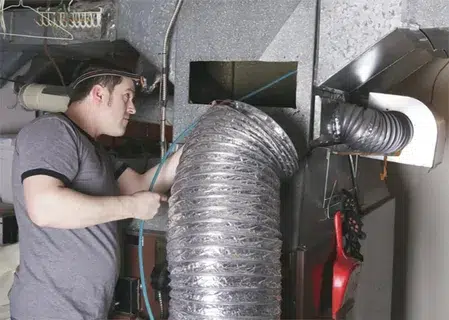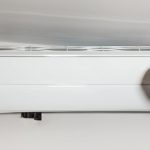Dust and allergens can make life uncomfortable, especially for those with allergies. Many homeowners wonder if air duct cleaning can help. Does cleaning ductwork stop dust? Will duct cleaning help with dust and improve air quality? These are common questions.
Air duct cleaning for allergies is a topic worth exploring. It involves removing dust, debris, and allergens from your home’s ductwork. This process can potentially reduce allergy symptoms and improve indoor air quality.
But how effective is it? Not all homes need frequent duct cleaning. Factors like location, pets, and allergies play a role.
In this article, we’ll explore the benefits and limitations of air duct cleaning. We’ll also provide tips for maintaining clean air ducts and better air quality.
Understanding Dust and Allergens in Air Ducts
Dust and allergens find their way into your home’s air ducts. Over time, they accumulate, creating an environment that can worsen allergies. Understanding what resides in your ducts is crucial for managing indoor air quality.
Air ducts often harbor a variety of contaminants. Common culprits include:
- Dust mites
- Pet dander
- Mold spores
- Pollen
- Dead skin cells
These particles can circulate through your home every time your heating or cooling system runs. This can trigger allergy symptoms for sensitive individuals. Regular duct cleaning can help manage this issue.
The buildup of dust in ducts may also hinder your HVAC system’s efficiency. This can lead to higher energy bills and reduced comfort. Cleaning ductwork is a way to ensure better airflow.
Recognizing the problem is the first step towards cleaner air. Let’s explore how the cleaning process works.
How Air Duct Cleaning Works
Air duct cleaning involves a systematic process to remove dust and allergens. Professional cleaners start by inspecting the ductwork. This helps identify areas of concern, such as mold or significant dust buildup.
Once inspected, the cleaning process begins. Specialized equipment is used to dislodge and extract contaminants from the ducts. This typically includes:
- High-powered vacuums
- Rotating brushes
- Compressed air tools
These tools ensure thorough cleaning, reaching every corner of your ductwork. The goal is to clear out debris and improve airflow throughout your system.
Finally, technicians may apply treatments to prevent future contamination. Sealing leaks or adding antimicrobial solutions can be part of the service. Ensuring ducts are clean is an essential step for maintaining healthy indoor air quality.
Will Duct Cleaning Help with Dust?
Air duct cleaning can significantly reduce dust in your home. Dust particles often accumulate in the ductwork over time. This buildup can lead to a dusty environment inside your living spaces.
By cleaning the air ducts, you can minimize the spread of dust. It removes both visible dust and unseen particles. This process helps improve overall indoor air quality for a healthier home.
For noticeable results, combine duct cleaning with other measures. These may include:
- Regular HVAC filter changes
- Routine house cleaning
- Using air purifiers
It’s important to note that duct cleaning alone isn’t a complete solution. However, it works best when part of a larger plan for reducing dust. This combined approach can contribute to a cleaner, more comfortable home environment.
Air Duct Cleaning for Allergies: What the Science Says
Research shows that dust and allergens accumulate in air ducts. These particles can trigger allergies in sensitive individuals. Cleaning air ducts may reduce allergens and provide relief to allergy sufferers.
However, studies present mixed findings on the effectiveness. Some indicate that cleaning may help, while others are less conclusive. Therefore, air duct cleaning should not be viewed as a cure-all for allergies.
Scientific reports suggest cleaning air ducts as part of a broader allergy management strategy. This strategy could also involve:
- Regular cleaning of home surfaces
- Use of HEPA filters in vacuums
- Controlling indoor humidity levels
Homeowners should approach duct cleaning with realistic expectations. While it might alleviate some symptoms, it isn’t guaranteed to eliminate allergies entirely. Consulting with an allergist can provide personalized advice for managing allergies effectively.
Signs Your Home Needs Air Duct Cleaning
Knowing when to clean your air ducts is key to maintaining good air quality. There are certain signs that indicate it might be time.
One sign is excessive dust, even right after cleaning. If dust seems to settle quickly, check your ducts.
Another indicator is a musty smell emanating from the vents. This could suggest mold growth inside the ducts.
Visible mold is another reason to consider cleaning. It poses health risks and should be addressed promptly.
Keep an eye out for the following signs:
- Unusual increase in allergies or asthma symptoms
- Insects or rodents in ductwork
- Significant increase in energy bills without reason
If you notice any of these signs, consider having your ducts inspected by professionals. Regular inspection can prevent major issues and ensure cleaner air in your home.

Professional vs. DIY Air Duct Cleaning
Deciding between professional and DIY air duct cleaning depends on your situation. Both have pros and cons to consider.
Professional services offer a thorough job, using specialized equipment. Their expertise ensures minimal damage to your ducts.
On the other hand, DIY methods can save money. However, they might not clean as comprehensively as professionals do.
Consider these points:
- Professionals have industry-grade tools
- DIY can be less costly upfront
- Professional cleaning offers efficiency and deep cleaning
- DIY might miss hidden debris
Professionals generally provide a more complete service. However, if you’re comfortable with tools and have a straightforward system, DIY is an option. Choose based on your comfort and the state of your ducts.
How Often Should You Clean Your Air Ducts?
Regular air duct cleaning varies per household needs. Still, a general guideline exists for maintaining fresh air.
On average, aim for every 3-5 years. This timeframe suits most homes.
Yet, certain conditions warrant more frequent cleaning:
- Home has pets
- Residents have allergies or asthma
- After major renovations
Each home is unique. Assess factors like dust levels or health needs to decide when cleaning is due. Regular checks keep air quality optimal.
Tips for Maintaining Clean Air Ducts and Better Air Quality
Keeping air ducts clean helps maintain a healthy home. Regular maintenance can make a difference.
Start with these simple practices:
- Change air filters regularly
- Keep vents and registers clean
- Use a vacuum with a HEPA filter
Each of these steps contributes to a dust-free environment. Clean ducts also work more efficiently, keeping energy bills down. Consistency in these habits will ensure improved indoor air quality.
Choosing a Reputable Air Duct Cleaning Service
Selecting a reliable service ensures effective air duct cleaning. Look for:
- Certification and experience
- Positive customer reviews
Verify the company uses modern equipment and follows best practices. A professional service can make a noticeable difference.
Conclusion: Does Cleaning Ductwork Stop Dust and Help Allergies?
Air duct cleaning can indeed reduce dust and assist with allergy relief. It’s a valuable component of maintaining a healthier home environment. While not a cure-all, it supports better air quality when combined with other efforts, like regular filter changes and overall HVAC maintenance.



